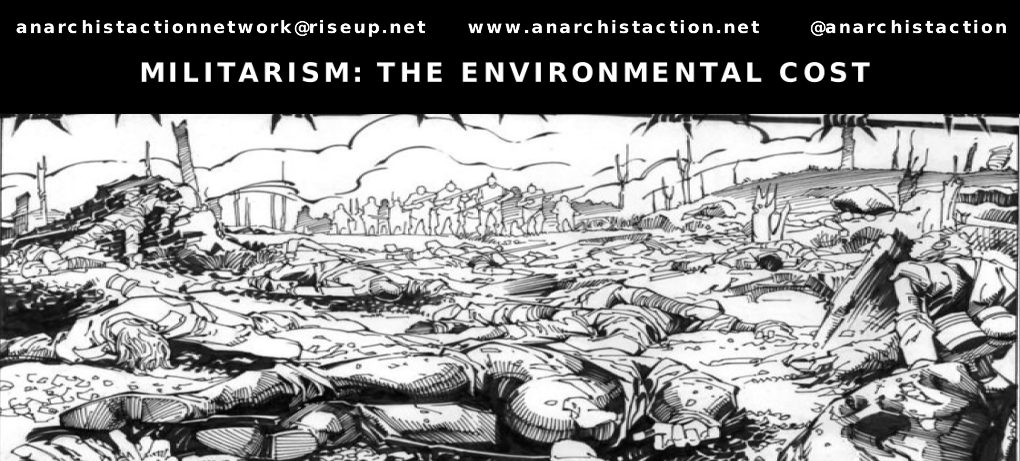
Download this page as printable leaflet (PDF)
View other DSEI leaflets
“Warfare in the modern era… results in environmental destruction of such a degree that it has been described as an ecological holocaust.”
The environmental impacts of war are hugely devastating:
- burning oil wells (eg the largest oil spill ever to hit the Mediterranean);
- the cluster bombs and depleted uranium munitions littering the countryside are killing, mutilating and poisoning;
- the defoliated landscape after chemical spraying, or indeed massive forest fires;
- the bombed sewage systems poisoning the groundwater.
CFCs
The US military is responsible for half of the worldwide use of CFC which accounts for 13 percent of overall global depletion. CO2 as a result of military activity up to 10% of total global emissions. The world’s military forces are responsible for the release of more than two thirds of CFC into the ozone layer. The US military is the world’s single largest polluter and generates more toxics annually than the top five chemical companies combined. The Pentagon is the single largest consumer of oil worldwide.
Oil consumption
In 1989 the Department of Defence purchased 2 billion barrels of oil for military use in 1989 – enough to run all of the U.S. public transit systems for 22 years. With Afghanistan, Iraq and Libya that’s likely to be a lot higher now! Approximately one quarter (42 million tons per year) or the world’s jet fuel is used by armed forces.
Metals
The worldwide military use of aluminium, copper, nickel and platinum is greater than the entire Global South demand for these materials. Globally, up to 1.5 million km2 of land are controlled by armed forces (same size as Mongolia), not including the area occupied by arms producing companies.
Battle testing and training
Even War Games cause severe degradation. Bombing ranges transform the land into wasteland. Shooting ranges for tanks and artillery contaminate soil and groundwater with lead and other toxic residues. Recovery can take thousands of years. Nuclear test sites = permanent contamination. Not to mention the low-level flights, which disrupt wildlife migrations and behavioural patterns. Virtually all of the world’s nuclear bomb test sites, as well as most uranium mines and radioactive dumps, occupy Native lands. Not unlike other toxic military activities. The US military (the world’s single largest polluter) is responsible for 27,000 toxic hot spots on 8,500 current and former military properties.
“Anywhere in the world, a military presence is the single most reliable predictor of environmental damage.”
Even where no military is present the environmental impact of the industry supporting it is devastating Take for example – the cost of aluminium production. 30% of all aluminium produced goes to the arms trade. Aluminium smelting is one of the most environmentally destructive processes .Bauxite is the raw material. It involves destruction of tropical rainforests, appropriation of indigenous lands, and chemical pollution to river and groundwater systems. ‘Land regeneration’ is a total myth, as can be seen in eg Jamaica, India, Trinidad, Australia. Aluminium smelting requires vast energy input – thus ‘clean energy’ produced by damming all of Iceland’s major glacial rivers and destroying Europe’s last remaining great wilderness.
“They have yet to learn that there is ONE COMMON STRUGGLE against those that have appropriated the EARTH, the MONEY and the MACHINES” – Voltairine de Cleyre
It’s not simply that militarism causes massive environmental damage. It’s also that, even if we arbitrarily separate them, they are both parts of the same system of domination, oppression, and destruction. Capitalism results in the need for continuous war and the military-industrial complex. It also demands ever increasing rates of resource extraction – with the inevitable environmental degradation and climate change that results.
What does UK militarism look like?
The brutal hardships and terrible environmental devastation experienced by people at the rough end of the arms trade, such as Afghanistan, Iraq or Palestine can seem a world away from our existence here in the UK. The state and the arms companies would like you to think that – but in reality we are situated right in the belly of the beast. The bombs might land far away but we are not so far removed. And unlike those living in regimes more overtly brutal towards their domestic populations, we face less risks. Our geographical and political position presents us with not only a unique responsibility, but also a unique opportunity, to make a difference and be effective.
Some examples of militarism in the UK:
- Across the country, military recruitment goes on for their dirty wars.
- Frequently the UK hosts International summits for the world’s political and military elite; most recently we ‘ve seen NATO and G8 Summits.
- Many arms companies’ corporate headquarters hide in our cities. And there are arms factories all over the UK that make equipment used in countless war zones, military occupations and repressive regimes.
- To grease the wheels and maintain the shiny corporate facade to the business of killing, luxury Arms dealers’ dinners and corporate hospitality events operate across the year.
- The UK government jointly hosts and heavily subsidises arms fairs such as DPRTE in Cardiff and Farnborough in the midlands. DSEi (‘Defence Security Equipment International’) is the world’s largest international arms fair. Held in Newham, East London, DSEi hosts buyers from some of the world’s most brutal and repressive regimes.
The next DSEI arms fair will be held in the third week of September 2015 at Newham’s Excel Centre in East London. There will be a week of action against the fair. More info will be available here in due course.
